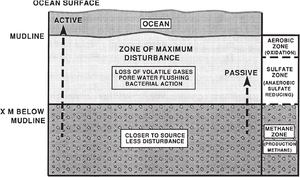Seepage activity and surficial geochemistry
| Exploring for Oil and Gas Traps | |

| |
| Series | Treatise in Petroleum Geology |
|---|---|
| Part | Predicting the occurrence of oil and gas traps |
| Chapter | Surface geochemical exploration for petroleum |
| Author | Dietmar Schumacher |
| Link | Web page |
| Store | AAPG Store |
Types of seepage activity
Seepage activity refers to the relative rate of hydrocarbon seepage. Abrams[1][2] defines two distinct end members of seepage activity: active and passive.
Active seepage
The term active seepage refers to areas where subsurface hydrocarbons seep in large concentrations into shallow sediments and soils and into the overlying water column. Active seeps often display acoustic anomalies on conventional or high-resolution seismic profiles. Active seepage occurs in basins now actively generating hydrocarbons or that contain excellent migration pathways. These seeps are easily detected by most sampling techniques.
Passive seepage
Areas where subsurface hydrocarbons are not actively seeping are referred to as characterized by passive seepage. Such seeps usually contain low-molecular-weight hydrocarbons and volatile high-molecular-weight hydrocarbons above background levels. Acoustic anomalies may be present, but water column anomalies are rare. Anomalous levels of hydrocarbon seepage may only be detectable near major leak points or below the zone of maximum disturbance.

Zone of maximum disturbance
The zone of maximum disturbance, defined by Abrams[1][2] is a near-surface zone of variable depth and thickness in which sedimentary and biological processes alter or destroy volatile hydrocarbons. Anomalous concentrations of hydrocarbons may not be detectable if samples are not obtained from below the zone of maximum disturbance. Figure 1 illustrates the zone of maximum disturbance in shallow marine sediments. Deeper sampling may be required in areas of passive seepage.
See also
- Principles of surface geochemical exploration
- Assumptions of surface geochemical exploration
- Limitations and uncertainties of surficial gechemistry
- Macroseepage vs. microseepage in surficial geochemistry
- Geochemical surface expression
References
- ↑ 1.0 1.1 Abrams, M., A., 1992, Geophysical and geochemical evidence for subsurface hydrocarbon leakage in the Bering Sea, Alaska: Marine and Petroleum Geology Bulletin, vol. 9, p. 208–221., 10., 1016/0264-8172(92)90092-S
- ↑ 2.0 2.1 2.2 Abrams, M., A., 1996, Distribution of subsurface hydrocarbon seepage in near-surface marine sediments, in Schumacher, D., Abrams, M., A., eds., Hydrocarbon Migration and Its Near-Surface Expression: AAPG Memoir 66, p. 1–14.